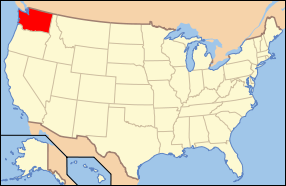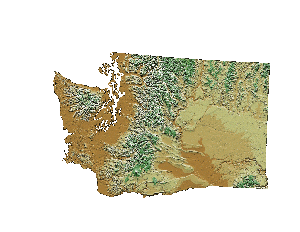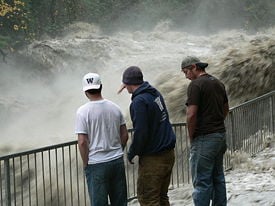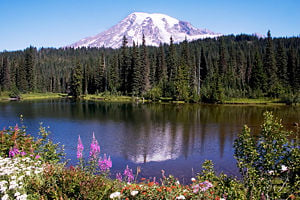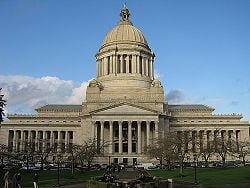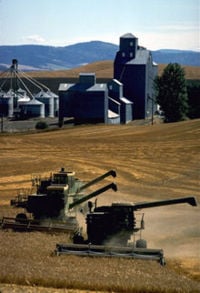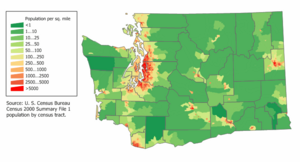| State of Washington | |||||||||||
| |||||||||||
| Capital | Olympia | ||||||||||
| Largest city | Seattle | ||||||||||
| Largest metro area | Seattle metropolitan area | ||||||||||
| Area | Ranked 18th | ||||||||||
| - Total | 71,300 sq mi (184,827 km²) | ||||||||||
| - Width | 240 miles (400 km) | ||||||||||
| - Length | 360 miles (580 km) | ||||||||||
| - % water | 6.6 | ||||||||||
| - Latitude | 45° 33′ N to 49° N | ||||||||||
| - Longitude | 116° 55′ W to 124° 46′ W | ||||||||||
| Population | Ranked 13th in the U.S. | ||||||||||
| - Total | 6,830,038 (2011 est)[2] | ||||||||||
| - Density | 103/sq mi (39.6/km2) Ranked 25th in the U.S. | ||||||||||
| - Median income | $58,078 (10th) | ||||||||||
| Elevation | |||||||||||
| - Highest point | Mount Rainier[3][4][5] 14,417 ft (4,394 m) | ||||||||||
| - Mean | 1,700 ft (520 m) | ||||||||||
| - Lowest point | Pacific Ocean[3] 0 ft (0 m) | ||||||||||
| Admission to Union | November 11, 1889 (42nd) | ||||||||||
| Governor | Christine Gregoire (D) | ||||||||||
| Lieutenant Governor | Brad Owen (D) | ||||||||||
| U.S. Senators | Patty Murray (D) Maria Cantwell (D) | ||||||||||
| Time zone | Pacific: UTC-8/-7 | ||||||||||
| Abbreviations | WA US-WA | ||||||||||
| Web site | access.wa.gov | ||||||||||
Washington is a state in the Pacific Northwest region of the United States of America. Washington is located in the uppermost corner of the Pacific Northwest bordering Canada.
Washington was carved out of the western part of Washington Territory and admitted to the Union as the 42nd state in 1889. In 2006, the Census Bureau estimated the state's population at 6,395,798. Residents are called "Washingtonians." Washington is sometimes called Washington state or The state of Washington to distinguish it from Washington, D.C., the U.S. capital.
The north-south transportation corridor along Interstate Highway 5 (I-5) stretches from the Canadian border passing directly through the major west coast cities of Seattle, Portland (Oregon), San Francisco, Los Angeles, and San Diego (California). Interstate Highway 5 connects Washington on the Canadian border within minutes to the large port city of Vancouver, Canada. Canada is the largest trade partner of the U.S. Three of the four main border portals with British Columbia, Canada are in Whatcom County, the most northwesterly county in Washington.
The natural beauty and climate of Washington's location make it an attractive place to live and many people have relocated to this region for this reason alone. With a burgeoning population growth since the 1990s, city and municipal planners are challenged to plan for new infrastructure and residential growth while maintaining an eye on protecting the environment that nature has so generously endowed.
Etymology
The state of Washington is named after George Washington, the first President of the United States. It is the only U.S. state named after a president.
Geography
Washington is the northwesternmost state of the contiguous United States. Its northern border lies mainly along the 49th parallel, with the Canadian province of British Columbia to the north. Washington borders Oregon to the south, with the Columbia River forming most of the boundary and the 46th parallel forming the eastern part of the southern boundary. To the east Washington borders Idaho, bounded mostly by the meridian running north from the confluence of the Snake River and Clearwater River (about 116°57' west), except for the southernmost section where the border follows the Snake River. To the west of Washington lies the Pacific Ocean.[6]
Washington is in the region known as the Pacific Northwest, a term which often includes part or all of British Columbia in Canada and part of Alaska. Sometimes it refers only to lands within the northwestern United States, including Oregon.
Topography
Washington is a land of contrasts. There are actually three distinct topographical regions of this state. The deep forests of the Olympic Peninsula, such as the Hoh Rain Forest, is part of temperate rainforest ecosystem that stretches from Oregon, up through Washington and British Columbia to the Alaskan coast. The semi-desert east of the Cascade Range has few trees but has rich volcanic soils from ancient basalt lava flows. The Rocky Mountain system extends from the Okanagan highlands in the northeast through the uplands of the Palouse Hills and Blue Mountains in the southeast region of Washington.
The Cascade Range contains several volcanoes, which reach altitudes significantly higher than the rest of the mountains. From the north to the south these volcanoes are Mount Baker, Glacier Peak, Mount Rainier, Mount Saint Helens, and Mount Adams. Mount Rainier, the highest mountain in the state,[3] is covered with more glacial ice than any other peak in the lower 48 states. Mount Saint Helens is currently the only Washington volcano that is actively erupting; however, all are considered active volcanoes.
Climate
The high mountains of the Cascade Range run north-south, bisecting the state. Western Washington, west of the Cascades, has a mostly marine west coast climate with relatively mild temperatures, wet winters, and dry summers. Western Washington also supports dense forests of conifers and areas of temperate rainforest. In contrast, Eastern Washington, east of the Cascades, has a relatively dry climate with large areas of semiarid steppe and a few truly arid deserts lying in the rainshadow of the Cascades; the Hanford reservation receives an average annual precipitation of between six and seven inches. Farther east, the climate becomes less arid. The Palouse region of southeast Washington was grassland that has been mostly converted into farmland. Other parts of eastern Washington are forested and mountainous.
Washington's climate varies greatly from west to east. An oceanic climate (also called "marine west coast climate") predominates in western Washington, and a much drier climate prevails east of the Cascade Range.
Major factors determining Washington's climate include the large semi-permanent high pressure and low pressure systems of the north Pacific Ocean, the continental air masses of North America, and the Olympic and Cascade mountains. In the spring and summer, a high pressure anticyclone system dominates the north Pacific Ocean, causing air to spiral out in a clockwise fashion. For Washington this means prevailing winds from the northwest bringing relatively cool air and a predictably dry season. In the autumn and winter, a low pressure cyclone system takes over in the north Pacific Ocean, with air spiraling inward in a counter-clockwise fashion. This causes Washington's prevailing winds to come from the southwest, bringing relatively warm and moist air masses and a predictably wet season. The term Pineapple Express is used to describe the extreme form of this wet season pattern.[7]
The coastal mountains and Cascades compound this climatic pattern by causing orographic lift of the air masses blown inland from the Pacific Ocean, resulting in the windward side of the mountains receiving high levels of precipitation and the leeward side receiving low levels. This occurs most dramatically around the Olympic Mountains and the Cascade Range. In both cases the windward slopes facing southwest receive high precipitation and mild, cool temperatures. In contrast, the leeward slopes facing northeast experience a rain shadow effect, with low precipitation and warmer temperatures. As a result, there are temperate rain forests on the southwest side of the Olympic Mountains while the northeast side has a drier climate sometimes called sub-mediterranean climate.[7] The San Juan Islands and the city of Sequim are known for their dry climate compared to the rest of the coastal region. The Olympic rain shadow extends into Canada. Terms like mediterranean, "sub-mediterranean," and "modified mediterranean" are sometimes used to describe the Olympic rainshadow region even though it is quite different from the standard "mediterranean" climate. The terms are mainly used to indicate a climate with wet winters and dry summers with regular drought conditions.
The Cascade Range forms a larger barrier than the Olympics and has a correspondingly stronger orographic effect. While the Puget Sound lowlands are known for clouds and rain in the winter, the western slopes of the Cascades receive larger amounts of precipitation, often falling as snow at higher elevations. East of the Cascades, a large region experiences strong rain shadow effects. Semi-arid conditions occur in much of eastern Washington with the strongest rain shadow effects at the relatively low elevations of the central Columbia River Plateau—especially the region just east of the Columbia River from about the Snake River to the Okanagan Highland. Thus instead of rain forests much of eastern Washington is covered with grassland and shrub-steppe.
The average annual temperature ranges from 51°F (10.6°C) on the Pacific coast to 40°F (4.4°C) in the northeast. The recorded temperature in the state has ranged from -48°F (-44.4°C) to 118°F (47.8°C) with both records set east of the Cascades. Western Washington is known for its mild climate, considerable fog, frequent cloud cover and long-lasting drizzles in the winter, and sunny and dry summers. The western region occasionally experiences extreme climate. Arctic cold fronts in the winter and heat waves in the summer are not uncommon. The western side of the Olympic Peninsula receives as much as 160 inches (4064 mm) of precipitation annually, making it the wettest area of the 48 conterminous states. Weeks or even months may pass without a clear day. The western slopes of the Cascade Range receive some of the heaviest annual snowfall (in some places more than 200 inches/5080 mm) in the country. In the rain shadow area east of the Cascades, the annual precipitation is only 6 inches (152 mm). Precipitation increases eastward toward the Rocky Mountains.
History
Prior to the arrival of explorers from Europe, this region of the Pacific Coast had many established tribes of Native Americans, each with its own unique culture. Today, they are most notable for their totem poles and their ornately carved canoes and masks. Prominent among their industries were salmon fishing and whale hunting. In the east, nomadic tribes traveled the land and missionaries such as the Whitmans settled there.
The first European record of a landing on the Washington coast was by Spanish Captain Don Bruno de Heceta in 1775, on board the Santiago, part of a two-ship flotilla with the Sonora. They claimed all the coastal lands up to the Russian possessions in the north for Spain.
In 1778, British explorer Captain James Cook sighted Cape Flattery, at the entrance to the Strait of Juan de Fuca, but the straits would not be explored until 1789, by Captain Charles W. Barkley. Further explorations of the straits were performed by Spanish explorers Manuel Quimper in 1790 and Francisco de Eliza in 1791, then by British Captain George Vancouver in 1792.
The Spanish Nootka Convention of 1790 opened the Northwest Territory to explorers and trappers from other nations, most notably Britain and then the United States. Captain Robert Gray (for whom Grays Harbor County is named) then discovered the mouth of the Columbia River. He named the river after his ship, the Columbia. Beginning in 1792, Gray established trade in sea otter pelts. The Lewis and Clark Expedition entered the state on October 10, 1805.
In 1819, Spain ceded their original claims to this territory to the United States. This began a period of disputed joint-occupancy by Britain and the U.S. that lasted until June 15, 1846, when Britain ceded their claims to this land with the Treaty of Oregon.
What was to become Washington state's first family was that of Washington's founder, the black pioneer George Washington Bush and his caucasian wife, Isabella James Bush, from Missouri and Tennessee, respectively. They led four white families into the territory and settled what is now Tumwater, Washington. They settled in Washington to avoid Oregon's racist settlement laws.[8]
Because of the overland migration along the Oregon Trail, many settlers wandered north to what is now Washington and settled the Puget Sound area. The first settlement was New Market (now known as Tumwater) in 1846. In 1853, Washington Territory was formed from part of Oregon Territory.
Washington became the 42nd state in the United States on November 11, 1889.
Early prominent industries in the state included agriculture and lumber. In eastern Washington, the Yakima Valley became known for its apple orchards, while the growth of wheat using dry-farming techniques became particularly productive. The heavy rainfall to the west of the Cascade Range produced dense forests, and the ports along Puget Sound prospered from the manufacturing and shipping of lumber products, particularly the Douglas fir. Other industries that developed in the state include fishing, salmon canning and mining. The city of Seattle boomed as it became a major stop for outfitting Yukon Gold Rushers in the 1890s. Several of Seattle's most wealthy families make their fortunes as mercantile magnates for the Gold Rush.
For a long period, Tacoma was noted for its large smelters where gold, silver, copper and lead ores were treated. Seattle was the primary port for trade with Alaska and the rest of the country, and for a time it possessed a large shipbuilding industry. The region around eastern Puget Sound developed heavy industry during the period including World War I and World War II, and the Boeing company became an established icon in the area.
During the Great Depression, a series of hydroelectric dams were constructed along the Columbia river as part of a project to increase the production of electricity. This culminated in 1941 with the completion of the Grand Coulee Dam, the largest concrete structure in the United States.
During World War II, the state became a focus for war industries, with the Boeing Company producing many of the nation's heavy bombers and ports in Seattle, Bremerton, Vancouver, and Tacoma were available for the manufacture of warships. Seattle was the point of departure for many soldiers in the Pacific, a number of which were quartered at Golden Gardens Park. In eastern Washington, the Hanford Works atomic energy plant was opened in 1943 and played a major role in the construction of the nation's atomic bombs.
On May 18, 1980, following a period of heavy tremors and eruptions, the northeast face of Mount Saint Helens exploded outward, destroying a large part of the top of the volcano. This eruption flattened the forests, killed 57 people, flooded the Columbia River and its tributaries with ash and mud, and blanketed large parts of Washington in ash, making day look like night.
Law and Government
The bicameral Washington State Legislature is the state's legislative branch. The state legislature is composed of a lower House of Representatives and an upper State Senate, with 49 legislative districts apiece. Districts for the House are multimember constituencies, electing two members per district, while a single member represents the district in the Senate. Currently for both houses of the legislature, the Democratic Party holds a majority in government. Both State Senators and House Representatives are elected for four year and two year terms, respectively. There are no term limits.
Washington's executive branch is headed by a governor elected for a four-year term.
The Washington Supreme Court is the highest court in the judiciary of the state of Washington. Nine justices serve on the bench, and are elected at large.
Politics
The state has been thought of as politically divided by the Cascade Mountains, with Western Washington being liberal (particularly the I-5 Corridor) and Eastern Washington being conservative. Since the population is larger in the west, the Democrats usually fare better statewide. More specifically, the Seattle metro area (especially King County) generally delivers strong Democratic margins, while the outlying areas of Western Washington were nearly tied in both 2000 and 2004. Washington has voted for the Democratic candidate in presidential elections in 1988, 1992, 1996, 2000 and 2004. It was considered a key swing state in 1968. In 1968, it was the only Western state to give its electoral votes to Hubert Humphrey. However, this state did participate in the 1994 Republican Revolution, and had the biggest pickup in the house for Republicans at six, making seven of the nine house members Republicans for the state of Washington.[9] However, this dominance held for only four years as the Democrats picked up one seat in the 1996 election[10] and two more in 1998, giving the Democrats a 5-4 majority.[11]
While the Democratic Party has long dominated Washington, the 2004 Washington gubernatorial election was among the closest races in United States election history. The initial count gave Republican candidate Dino Rossi a lead of 261 votes out of a total vote count of 2,805,913.[12] Washington law calls for a mandatory machine recount if the difference between the candidates is less than 0.5 percent and 2,000 votes.[13] The mandatory recount again had Rossi in the lead, but it was now by 42 votes of the total 2,808,341 votes included in the first recount.[14] A second recount was done by hand, at the request of the Democratic party as allowed by law. This final recount overturned the initial results and resulted in a lead for Christine Gregoire, the Democratic candidate, of 129 votes of the 2,810,058 votes cast.[15] As this second recount was the last allowed for by Washington election law, Gregoire was inaugurated on January 12, 2005. Subsequent court battles raged for months after the election. A judge identified 1,678 illegal votes from both parties that included votes from felons, dead people, mishandled ballots and more. These findings in the course of searching for the final number of votes for the candidates was revealing of the inadequacies of the present voting system and disheartening for the general public. The final official count left Gregoire holding her office by 133 votes.[16]
Washington holds the distinction of being the first and only state in the country to have elected women to all three major statewide offices (governor Chris Gregoire and U.S. Senators Patty Murray and Maria Cantwell) at the same time.
Economy
Washington's position on the Pacific Ocean and the harbors of Puget Sound give the state a leading role in maritime trade with Alaska, Canada, and the Pacific Rim. Puget Sound's many islands are served by the largest ferry fleet in the United States.
Significant businesses within the state include the design and manufacture of jet aircraft (Boeing), computer software development (Microsoft, Amazon.com, Nintendo of America), electronics, biotechnology, aluminum production, lumber and wood products (Weyerhaeuser), mining, and tourism. The state has significant amounts of hydroelectric power generation. Significant amounts of trade with Asia pass through the ports of the Puget Sound. A Fortune magazine survey of the top 20 Most Admired Companies in the U.S. includes four Washington based companies: Starbucks, Microsoft, Costco and Nordstrom.[17]
The state of Washington has the most regressive tax structure in the U.S. It is one of only seven states that does not levy a personal income tax. The state also does not collect a corporate income tax. However, Washington businesses are responsible for various other state levies. Washington's state sales tax is 6.5[18] percent, and it applies to services as well as products.[19] Most foods are exempt from sales tax; however, prepared foods, dietary supplements and soft drinks remain taxable. The combined state and local retail sales tax rates increase the taxes paid by consumers, depending on the variable local sales tax rates, generally between 8 and 9 percent.[20] An excise tax applies to certain select products such as gasoline, cigarettes, and alcoholic beverages. Property tax was the first tax levied in the state of Washington and its collection accounts for about 30 percent of Washington's total state and local revenue. It continues to be the most important revenue source for public schools, fire protection, libraries, parks and recreation, and other special purpose districts.
All real property and personal property is subject to tax unless specifically exempted by law. Personal property also is taxed, although most personal property owned by individuals is exempt. Personal property tax applies to personal property used when conducting business or to other personal property not exempt by law. All property taxes are paid to the county treasurer's office where the property is located. Washington does not impose a tax on intangible assets such as bank accounts, stocks or bonds. Neither does the state assess any tax on retirement income earned and received from another state. Washington does not collect inheritance taxes; however, the estate tax is decoupled from the federal estate tax laws, and therefore the state imposes its own estate tax.
Washington is one of 18 states which has a government monopoly on sales of alcoholic beverages, although beer and wine with less than 20 percent alcohol by volume can be purchased in convenience stores and supermarkets. Bill Gates (worth $59.2 billion), the second wealthiest man in the world, is the best known billionaire from the state.[21]
Other Washington state billionaires include Paul Allen (Microsoft), Steve Ballmer (Microsoft), Jeffrey Bezos (Amazon), Craig McCaw (McCaw Cellular), James Jannard (Oakley), Howard Schultz (Starbucks), and Charles Simonyi (Microsoft).[22]
Agriculture
Washington is a leading agricultural state. (The following figures are from the Washington State Office of Financial Management and the Washington Agricultural Statistics Service.)
For 2003, the total value of Washington's agricultural products was $5.79 billion, the 11th highest in the country. The total value of its crops was $3.8 billion, the 7th highest. The total value of its livestock and specialty products was $1.5 billion, the 26th highest.
In 2004, Washington ranked first in the nation in production of red raspberries (90 percent of total U.S. production), wrinkled seed peas (80.6 percent), hops (75 percent), spearmint oil (73.6 percent), apples (58.1 percent), sweet cherries (47.3 percent), pears (42.6 percent), peppermint oil (40.3 percent), Concord grapes (39.3 percent), carrots for processing (36.8 percent), and Niagara grapes (31.6 percent). and 6th in the nation for the blueberry harvest. Washington also ranked second in the nation in production of lentils, fall potatoes, dry edible peas, apricots, grapes (all varieties taken together), asparagus (over a third of the nation's production), sweet corn for processing, and green peas for processing; third in tart cherries, prunes and plums, and dry summer onions; fourth in barley and trout; and fifth in wheat, cranberries, and strawberries.
Transportation
Washington has a system of state highways, called State Routes, as well as an extensive ferry system which is the largest in the nation [23] as well as the third largest in the world. There are 140 public airfields in Washington, including 16 state airports owned by the Washington State Department of Transportation. Boeing Field in Seattle is one of the busiest primary non-hub airports in the U.S.[24] The unique geography of Washington presents exceptional transportation needs.
There are extensive waterways in the midst of Washington's largest cites, including Seattle, Bellevue, Tacoma and Olympia. The state highways incorporate an extensive network of bridges to serve transportation needs in the Puget Sound area. Washington's marine highway constitutes a fleet of 28 ferries that navigate Puget Sound and its inland waterways to 20 different ports of call. Washington is home of four of the five longest floating bridges in the world: the Evergreen Point Floating Bridge, Lacey V. Murrow Memorial Bridge and Homer M. Hadley Bridge over Lake Washington, and the Hood Canal Bridge which connects the Olympic Peninsula and Kitsap Peninsula.
The Cascade Mountain Range also provides unique transportation challenges. Washington operates and maintains roads over seven major mountain passes and 8 minor passes. During winter months some of these passes are plowed, sanded, and kept safe with avalanche control. Not all are able to stay open through the winter. The North Cascades Highway on State Route 20 closes every year from the autumn until spring. This is because of the extraordinary amount of snowfall and frequency of avalanches, leading to it not being safe in the winter months.
Education
In order to scrutinize the standards in statewide public education it is official policy that public school students must be tested with a state standardized test called the WASL (Washington Assessment of Student Learning) beginning in the 4th grade. In order to receive a high school diploma in Washington State from 2013, all students will have to pass the 10th grade WASL in most components. Opportunities to rewrite it if necessary are given to get a passing grade and there are a few other options a student may take to satisfy the state education standards for a public high school diploma in Washington.
There is a wide array of secondary educational institutions throughout the state for all disciplines. Most cities have their own community colleges.
Colleges and universities
State universities
- Central Washington University. In 2004 a record total of 9,616 students were studying at CWU, a two-percent increase over 2003 and a 19.5-percent jump from fall 2000. Located in Ellensburg.
- Eastern Washington University. Located in Cheney there were 9,775 students taking classes in the 2004 fall quarter, its highest-ever enrollment, marking the 13th consecutive quarter of record enrollments at the University.
- The Evergreen State College. Liberal arts and sciences college located in Olympia with a fall 2007 enrollment of 4500.
- University of Washington. Founded in 1861 it one of the oldest state-supported institutions of higher education on the West Coast and is one of the preeminent research universities in the world. Campuses in Seattle, Tacoma and Bothell.
- Washington State University. With four campuses it has a total enrollment of 23,428. The University opened its doors in 1892 as the Washington Agricultural College and School of Science. Over 100 years later it has become a nationally recognized research university.
- Western Washington University. For ten years in a row, U.S. News and World Report has ranked Western Washington University as the best regional public university in the Pacific Northwest, and No. 2 in the western United States. Located in Bellingham it has an enrollment of 13,000 students.
Private universities
|
|
Demographics
Washington had an estimated population of 6,830,038 in 2011[2] Of Washington's population: 6.7 percent was reported as under 5; 25.7 percent under 18; and 11.2 percent were 65 or older. Females made up approximately 50.2 percent of the population.
As of the Census 2000, the Seattle-Tacoma-Bellevue Metropolitan Area's population was 3,043,878, about half the state's total population.[25]
As of 2004, Washington's population included 631,500 foreign-born (10.3 percent of the state population), and an estimated 100,000 illegal aliens (1.6 percent of state population).[26]
The six largest reported ancestries in Washington are: German (18.7 percent), English (12 percent), Irish (11.4 percent), Norwegian (6.2 percent), Mexican (5.6 percent) and Filipino (3.7 percent).
There are many migrant Mexican farm workers living in the southeast-central part of the state, though the population is also increasing as laborers in Western Washington. Wahkiakum County, as well as most counties in the state, has many residents of Scandinavian origin
Washington has the fifth largest Asian population of any state. The Filipino community is the largest Asian American subgroup in the state. Gary Locke was elected as the first Asian American governor at the end of the 20th century.
African-Americans are less numerous than Asians or Hispanics in many communities, but have been elected as mayor of Seattle, Spokane and Lakewood and as King County Executive. In Seattle, minorities are moving into the southern part of the city as well as many suburban areas such as South King County. Tacoma also has a rising African-American population.
Washington is the location of many Native American [27]or First Nations reservations, with some placing prominent casinos next to major interstate highways. The traditional artwork style of the Northwest Coast Indians is widely visible to the public through such well known designs as the logo that represents the Seattle Seahawks professional football team. The west coast aboriginal tribes are noted for their wood carving craftsmanship of totem poles, longhouses, dugout canoes and traditional stylized depictions of native animals. Many Washington cities are named after Native Americans or tribes such as Yakima, Seattle, Spokane, Puyallup, and Walla Walla.
Religion
Major religious affiliations of the people of Washington are:[28]
- Protestant: 49 percent
- Evangelical: 25 percent
- Protestant Mainline: 23 percent
- Other Protestant: 1 percent
- Unaffiliated: 23 percent
- Catholic: 16 percent
- Mormon: 2 percent
- Jewish: 1 percent
- Muslim: .5 percent
- Other religions 3 percent
The largest denominations by number of adherents in 2010 were the Roman Catholic Church with 784,332; The Church of Jesus Christ of Latter-day Saints (Mormon) with 267,267; and the Assemblies of God with 125,005.[29]
Aquarian Tabernacle Church is the largest Wiccan church in the country.[30]
As with many other Western states, the percentage of Washington's population identifying themselves as "non-religious" is higher than the national average. The percentage of non-religious people in Washington is the highest of any state other than Colorado.[31]
Environment
In 2007, Washington became the first state in the nation to target all forms of highly toxic brominated flame retardants known as PBDEs for elimination from the many common household products in which they are used.
Three recent studies by the Washington Department of Ecology showed that toxic chemicals banned decades ago continue to linger in the environment and concentrate in the food chain In one of the studies, state government scientists found unacceptable levels of toxic substances in 93 samples of freshwater fish collected from 45 sites. The toxic substances included PCBs; dioxins, two chlorinated pesticides, DDE and dieldrin, and PBDEs. As a result of the study, the department will investigate the sources of PCBs in the Wenatchee River, where unhealthy levels of PCBs were found in mountain whitefish. Based on the 2007 information and a previous 2004 Ecology study, the Washington Department of Health is advising the public not to eat mountain whitefish from the Wenatchee River from Leavenworth downstream to where the river joins the Columbia, due to unhealthy levels of PCBs. Study results also indicated high levels of contaminants in fish tissue that scientists collected from Lake Washington and the Spokane River, where fish consumption advisories are already in effect.
Professional sports
There are a host of professional and semi-professional sports organizations from the state of Washington. The best known national league teams are the Seattle Seahawks (NFL), the Seattle Mariners (Major League Baseball) and the Seattle Supersonics National Basketball Association (NBA). The Seattle Storm is the women's counterpart to the Supersonics (WNBA).
Miscellaneous topics
| State symbols |
|
State symbols
Nicknamed "The Evergreen State" for its abundant evergreen forests, by C.T. Conover, Washington has never officially adopted the name, though it is used on its vehicle license plates. The state also has never officially adopted a motto, though the Native American word, Alki, meaning "bye and bye" was the territorial motto and is still in use.
The Washington State Seal, which is featured in the state flag, was inspired by the unfinished portrait of George Washington by Gilbert Stuart.
Federal land and reservations
There are three national parks in Washington, Mount Rainier National Park, North Cascades National Park, and Olympic National Park.
National forests in the state include Colville National Forest, Gifford Pinchot National Forest, Mount Baker-Snoqualmie National Forest, Okanogan National Forest, Olympic National Forest, and Wenatchee National Forest.
Protected lands administered by the National Park Service include Columbia River Gorge National Scenic Area, Lake Chelan National Recreation Area, Mount St. Helens National Volcanic Monument, Ross Lake National Recreation Area, Lake Roosevelt National Recreation Area, and Fort Vancouver National Historic Site.
There are many wilderness designated areas in Washington, including Alpine Lakes Wilderness, Glacier Peak Wilderness, Goat Rocks Wilderness, Henry M. Jackson Wilderness, Norse Peak Wilderness, Mount Baker Wilderness, and Pasayten Wilderness, Olympic Wilderness.
There are several large military-related reservations, including Fort Lewis, McChord Air Force Base, Naval Base Kitsap, the Hanford Site, and the Yakima Training Center.
There are many Indian reservations in Washington. The largest include the Colville Indian Reservation, Spokane Indian Reservation, Yakama Indian Reservation, and the Quinault Indian Reservation.
Three ships of the United States Navy, including two battleships, have been named USS Washington in honor of the state. Previous ships had held that name in honor of George Washington.
Notes
- ↑ Washington State Legislature, State Symbols. Retrieved February 23, 2012.
- ↑ 2.0 2.1 Error on call to template:cite web: Parameters url and title must be specified (CSV). 2011 Population Estimates. United States Census Bureau, Population Division (December 2011).
- ↑ 3.0 3.1 3.2 Elevations and Distances in the United States. United States Geological Survey (2001). Retrieved October 24, 2011.
- ↑ Elevation adjusted to North American Vertical Datum of 1988.
- ↑ The summit of Mount Rainier is the most prominent point in the Contiguous United States.
- ↑ Washington State Constitution, Article XXIV Boundaries. Retrieved October 18, 2007.
- ↑ 7.0 7.1 Arthur R. Kruckeberg. The Natural History of Puget Sound Country. (Seattle: University of Washington Press, 1991), 42-46.
- ↑ City of Tumwater, July 18, 2005. Articles on George Washington Bush Retrieved October 25, 2007.
- ↑ Elections:November 1994 General Secstate.wa.gov. Retrieved October 18, 2007.
- ↑ Elections:November 1996 General Secstate.wa.gov. Retrieved October 18, 2007.
- ↑ Elections:November 1998 General Secstate.wa.gov. Retrieved October 18, 2007.
- ↑ 2004 General Election Results Vote.wa.gov. Retrieved October 18, 2007.
- ↑ Rules for Mandatory Recount Secstate.wa.gov. Retrieved October 18, 2007.
- ↑ 2004 Washington State Gubernatorial Election 1st Recount Results Vote.wa.gov. Retrieved October 18, 2007.
- ↑ 2004 Washington State Gubernatorial Election 2nd Recount Results Vote.wa.gov. Retrieved October 18, 2007.
- ↑ Gregory Roberts, Judge upholds Gregoire's election; Rossi won't appeal Seattle Post Intelligencer, June 6, 2005. Retrieved October 18, 2007.
- ↑ Top 20 Most Admired CompaniesCNN Money.com. Retrieved October 25, 2007.
- ↑ Tax Rate Lookup Tool Department of Revenue Washington State. Retrieved October 30, 2007.
- ↑ Tax Rate Lookup Tool Department of Revenue Washington State. Retrieved October 30, 2007.
- ↑ Tax Rate Lookup Tool Department of Revenue Washington State. Retrieved October 18, 2007.
- ↑ Paul McDougall, July 5, 2007. Bill Gates Passed By Mexican Telecom Tycoon As World's Richest Man Information Week. Retrieved October 25, 2007.
- ↑ Frank Ahrens, September 22, 2006. No news here … Gates still richest Seattle Times. Retrieved October 18, 2007.
- ↑ Largest Ferry System in the Nation Wsdot.wa.gov. Retrieved October 18, 2007.
- ↑ King County International Airport/Boeing Field Metrokc.gov. Retrieved October 18, 2007.
- ↑ Population in Metropolitan Statistical Areas Ranked by 2000 Census. U.S. Census Bureau.
- ↑ Washington Facts 50states.com. Retrieved October 16, 2007.
- ↑ Tribes of Washington State.Burke Museum of Natural History and Culture. Retrieved July 12, 2008.
- ↑ Pew Forum on Religion & Public Life Pew Research Center. Retrieved May 21, 2015.
- ↑ State Membership Report The Association of Religion Data Archives. Retrieved May 21, 2015.
- ↑ Cyndi Duval, Wicca more prevalent in the Pacific Northwest than most realize Christian Examiner, November 1, 2007. Retrieved May 21, 2015.
- ↑ Patricia O'Connell Killen and Mark Silk (eds.), Religion and Public Life in the Pacific Northwest: The None Zone (AltaMira Press, 2004, ISBN 0759106258).
- ↑ Symbols of Washington State Washington State Legislature. Retrieved October 18, 2007.
ReferencesISBN links support NWE through referral fees
- Alt, David D., and Donald W. Hyndman. Roadside Geology of Washington. Missoula, MT: Mountain Press Pub. Co., 1984. ISBN 0878421602
- Dorpat, Paul, and Genevieve McCoy. Building Washington a History of Washington State Public Works. Seattle, WA: Tartu Publications, 1998. ISBN 0961435798
- Judd, Ron C. Inside out Washington. Seattle: Sasquatch Books Seattle, 2007. ISBN 1570610983
- Killen, Patricia O'Connell, and Mark Silk (eds.). Religion and public life in the Pacific Northwest the none zone: Religion by region, 1. Walnut Creek, CA: AltaMira Press, 2004. ISBN 0759106258
- Kirk, Ruth, and Richard D. Daugherty. Archaeology in Washington. Seattle: University of Washington Press, 2007. ISBN 9780295986975
- Kruckeberg, Arthur R. The Natural History of Puget Sound Country. University of Washington Press, 1991. ISBN 029597477X
- Nelson, Joanne, and Melody Howatson. The ABC History of Washington State. Edmonds, WA: CLS Enterprises, 1990. ISBN 0944948057
- Pearson, Arnold, and Esther Pearson. Early Churches of Washington State. Seattle: University of Washington Press, 1980. ISBN 0295957131
- Pojar, Jim, and Andy Mackinnon. Plants of the Pacific Northwest Coast: Washington, Oregon, British Columbia, and Alaska. Edmonton; Auburn, WA Lone Pine Publishing, 2004. ISBN 9781055305.
External links
All links retrieved May 3, 2023.
- State of Washington website
- Constitution of the State of Washington
- USGS real-time, geographic, and other scientific resources on Washington
- Washington State Information - TheUS50.com
| Political divisions of the United States | |||||||
|---|---|---|---|---|---|---|---|
| |||||||
Credits
New World Encyclopedia writers and editors rewrote and completed the Wikipedia article in accordance with New World Encyclopedia standards. This article abides by terms of the Creative Commons CC-by-sa 3.0 License (CC-by-sa), which may be used and disseminated with proper attribution. Credit is due under the terms of this license that can reference both the New World Encyclopedia contributors and the selfless volunteer contributors of the Wikimedia Foundation. To cite this article click here for a list of acceptable citing formats.The history of earlier contributions by wikipedians is accessible to researchers here:
The history of this article since it was imported to New World Encyclopedia:
Note: Some restrictions may apply to use of individual images which are separately licensed.


